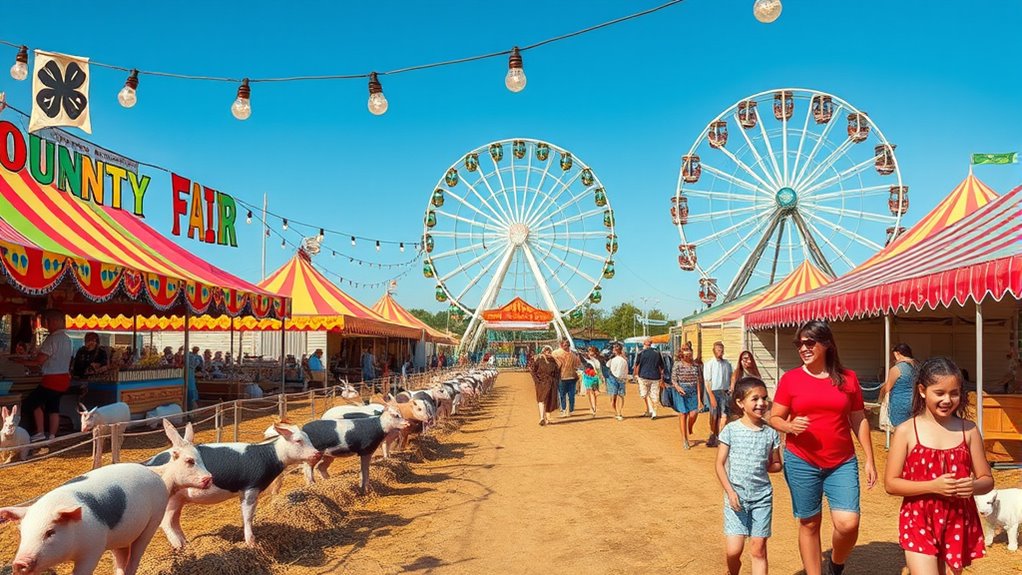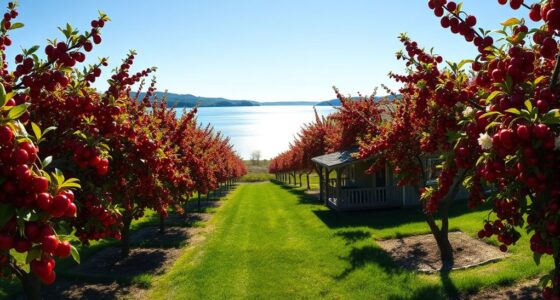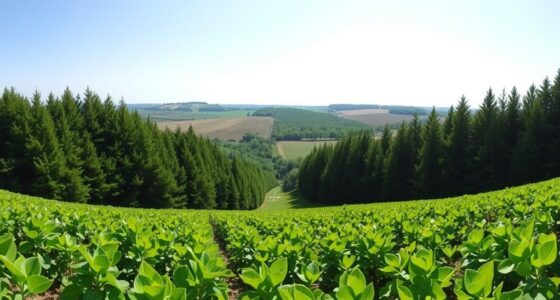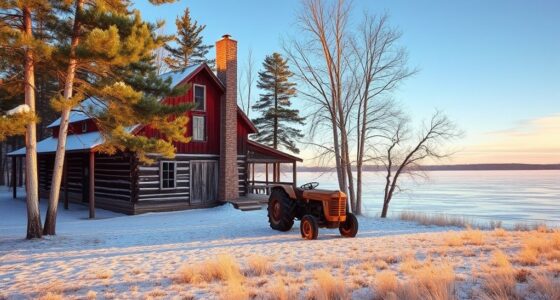County fairs and 4-H clubs offer a rich regional tradition where you can experience community bonding, hands-on agricultural learning, and youth leadership. You’ll see local culture celebrated through livestock shows, crafts, and demonstrations, while gaining skills in animal husbandry, sustainable practices, and teamwork. These events strengthen community ties and uphold shared values that last across generations. To discover how these traditions shape rural life and communities, keep exploring what makes them so special.
Key Takeaways
- County fairs and 4-H clubs serve as vital community events that promote agricultural education and cultural traditions.
- They provide hands-on learning opportunities in sustainable farming, animal husbandry, and crop production.
- Participation fosters youth leadership, confidence, teamwork, and community engagement through competitions and projects.
- These events feature workshops, demonstrations, and displays that inspire interest in agricultural science and careers.
- County fairs and 4-H clubs strengthen regional identities and preserve rural heritage across generations.
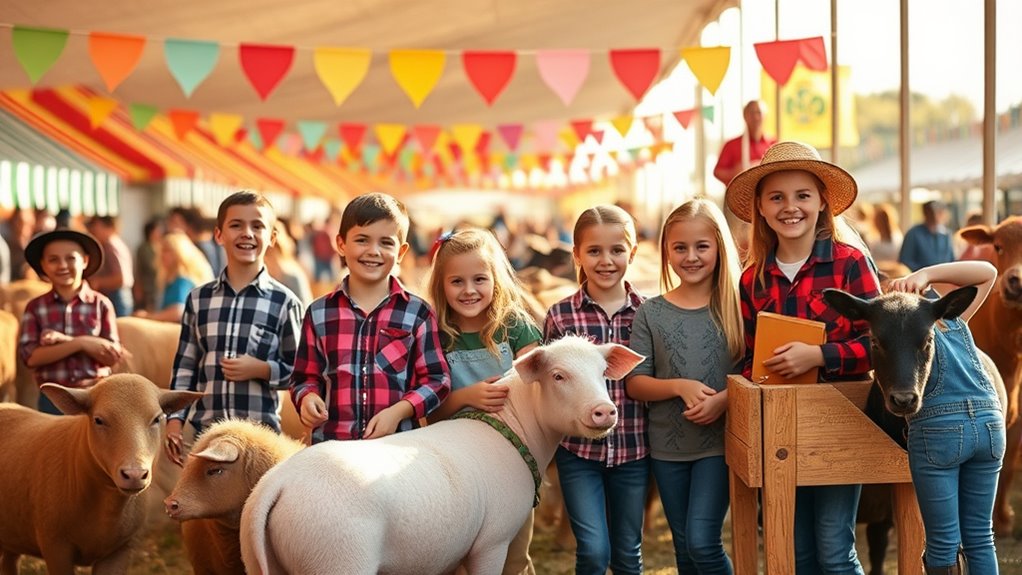
Regional county fairs and 4-H clubs play an essential role in bringing communities together and fostering hands-on learning. When you attend these events, you’re not just enjoying rides and fair food—you’re engaging in a crucial part of agricultural education that helps young people develop skills and knowledge about farming, livestock, and rural life. These fairs serve as living classrooms where youth can learn about sustainable practices, animal husbandry, and crop production through direct experience. By participating in 4-H projects, you gain practical skills that are foundational to understanding agriculture’s importance in our society.
As you get involved in 4-H clubs, you step into a leadership role that teaches youth leadership—an invaluable skill in today’s world. These clubs encourage you to take initiative, organize events, and collaborate with peers, fostering confidence and communication skills. You learn that leadership isn’t just about guiding others; it’s about responsibility, problem-solving, and inspiring your community. County fairs act as a showcase for this growth, offering opportunities to present projects and compete in competitions that highlight your achievements. This environment motivates you to push your limits, learn from feedback, and celebrate your progress.
The sense of community at these fairs is powerful. You meet people from diverse backgrounds who share a common interest in agriculture and rural traditions. These events create a space where you can exchange ideas, learn from experienced farmers, and connect with mentors. It’s a place where the local culture is celebrated through livestock shows, craft displays, and agricultural demonstrations. For youth, participating in these activities isn’t just about winning ribbons; it’s about building relationships, gaining respect, and understanding the value of teamwork.
Moreover, county fairs often include educational workshops and seminars designed to deepen your agricultural knowledge. These sessions might cover topics like soil health, pest management, or modern farming techniques. Attending them can spark your curiosity and inspire future career paths in agriculture, environmental science, or rural development. The hands-on nature of these experiences ensures that you don’t just learn theory—you see, touch, and do, making the learning meaningful and memorable.
Ultimately, county fairs and 4-H clubs are more than just annual events—they’re platforms for nurturing youth leadership, promoting agricultural education, and strengthening community bonds. When you participate, you’re part of a tradition that values hard work, innovation, and shared knowledge. This connection to your community and the land underscores the importance of sustaining these regional traditions for generations to come.
Frequently Asked Questions
How Do I Join a Local 4-H Club?
To join a local 4-H club, start by visiting your county’s extension office or website. Express your interest in exploring 4-H projects and community outreach activities. They’ll provide you with information about upcoming meetings and how to sign up. You can also talk to current members or leaders to learn more. Get involved early to enjoy hands-on projects and make a positive impact in your community.
What Are the Age Requirements for 4-H Participation?
They say “age is just a number,” and in 4-H, that’s true. You can start as early as 5 years old in Cloverbuds, focusing on youth development and community engagement. For traditional 4-H clubs, the upper age limit is typically 18, though some programs extend to 19 or 21. No matter your age, 4-H offers a great way to build skills, make friends, and serve your community.
How Are Fair Winners Chosen and Announced?
You watch the awarding ceremonies closely, as fair winners are chosen based on their project quality, presentation, and adherence to rules. The announcement procedures typically involve a designated presenter calling out winners’ names aloud, often with applause from the crowd. You can expect the winners to be celebrated publicly, receiving ribbons or trophies, and the event creates a festive atmosphere that highlights the hard work and talent of all participants.
Can Visitors Participate in Fair Activities?
Visiting a fair is like stepping into a lively community festival—you can definitely join in! You can participate in activities like baking contests, craft booths, or livestock shows, especially if you volunteer or sign up early. These fair traditions thrive on community involvement, so your participation helps keep them alive. Whether you’re helping out or just trying your hand at a game, your involvement enriches the experience for everyone.
What Are the Most Popular Fair Competitions?
You’ll find that agricultural exhibits and livestock shows are the most popular fair competitions. You can watch or even participate in these events, showcasing everything from prize-winning vegetables to impressive farm animals. These competitions highlight local farming skills and community pride, drawing crowds enthusiastic to see the best in agriculture. Whether you’re observing or competing, these contests are the heart of the fair experience, offering entertainment and education for all ages.
Conclusion
You might think county fairs and 4-H clubs are just small-town traditions, but they actually play a crucial role in shaping responsible, skilled young leaders. Some believe these events foster community resilience and innovation, which research shows can boost local economies and social bonds. So, your participation isn’t just about fun; it’s about nurturing a future where tradition and progress go hand in hand, proving that regional events truly make a lasting impact.

